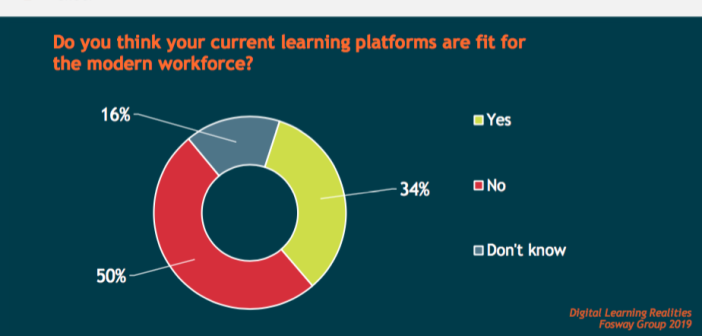A snapshot of useful research for L&D and workplace professionals.
Why read this report?
It tells you what other L&D professionals think about their learning technologies, what they are using it for and how well it is working. If you are researching new learning technologies or simply keen to know where the learning technology market is heading then this is for you.
About the research
At the time of writing the research was still open. The current iteration of the research report is based on the responses of more than 800 L&D professionals. The majority (88%) are Europe based and 11% are based in APAC. Most respondents work in organisations with more than 1,000 employees. The research has been carried out by learning analysts Fosway Group in association with Learning Technologies.
Standout stats
This report features quite a few surprising and challenging stats. The most alarming is that 50% of respondents do not think their current learning platforms are fit for the modern workforce, 16% don’t know and only 34% say they are fit for workers.
It may not be surprising that 68% of organisations say their digital transformation journey is in progress but it may surprise you that 25% are in planning, so have not yet started on their journey. The good news is that investment in digital learning will increase over the coming year with more than 50% of respondents saying they will be spending more on digital learning content and digital learning platforms. There will be a smaller investment in the digital learning team, digital learning services and outsourced digital learning.
At a more granular level, the report shows what digital learning will look like for organisations. The top growth areas for content are:
- Blended learning 74%
- Video 74%
- User-generated content 64%
- Microlearning 59%
- Performance support 56%
And for learning platforms, the top growth areas are:
- Analytics 75%
- Social/collaborative 70%
- Virtual classrooms 68%
- Authoring systems 61%
- Learner engagement 53%
- Learning experience platforms 44%
And the priority areas for improving digital learning also provide further insight into what L&D teams want for learning. These include:
Measuring learning outcomes, impact and success, followed by multichannel learning delivery and supporting employees’ application of learning on the job. It is not surprising that measuring impact is a priority as 53% of respondents report they are ineffective at measuring impact and 33% don’t measure it at all. Only 14% say they are effective at measuring learning impact.
One final stat that is worth considering is that 85% of respondents do not have a standardised approach to their learning technologies. That might a problem when an L&D team is using multiple tools as a part of a digital learning ecosystem. Over time the ecosystem could become large and difficult to manage. It might also fail to provide a seamless experience for employees.
Final word
This is the only piece of research that covers learning technologies in this way and at this scale and that is publicly and freely available. If you are in L&D and are involved in digital delivery then this really is essential reading.
- Report reading time: 10 minutes
- Media: PDF
- Link: http://ow.ly/F0AG30nQ9lO




